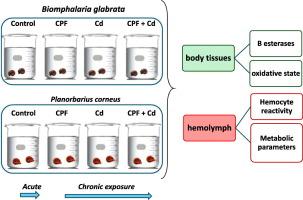Exposure of freshwater gastropods to chlorpyrifos and cadmium: Predictable and unpredictable responses
IF 4.3
3区 环境科学与生态学
Q2 BIOCHEMISTRY & MOLECULAR BIOLOGY
Comparative Biochemistry and Physiology C-toxicology & Pharmacology
Pub Date : 2025-07-11
DOI:10.1016/j.cbpc.2025.110287
引用次数: 0
Abstract
Aquatic environments near agricultural areas are increasingly contaminated by mixtures of pesticides and heavy metals, posing a threat to non-target aquatic invertebrates. Because mixtures may induce unexpected biological responses, their study is essential for realistic environmental risk assessment. This study investigated the acute and chronic effects of the pesticide chlorpyrifos (CPF), cadmium (Cd), and their mixture on the freshwater gastropods Biomphalaria glabrata and Planorbarius corneus under controlled laboratory conditions. A panel of biochemical and cellular biomarkers was used to evaluate neurotoxicity, oxidative stress, metabolic alterations and immunotoxicity.
Acute CPF exposure, alone or combined with Cd, inhibited B-esterase activity and increased TBARS, indicating neurotoxic and pro-oxidant effects. Glutathione-S-transferase (GST) and catalase (CAT) remained unaltered. Hemolymph glucose levels increased with all treatments, with a synergistic hyperglycemic response to CPF + Cd observed only in B. glabrata. Cd exposure induced hypercholesterolemia in B. glabrata and hypertriglyceridemia in both species. Hemocyte revealed enhanced reactivity in response to contaminants alone, an effect absent in the mixture. Notably, under chronic CPF + Cd exposure, a pronounced hemocyte clumping occurred, an immunotoxic response, not previously reported.
These findings highlight B-esterase inhibition and lipid peroxidation as sensitive biomarkers of acute CPF exposure; while hemolymph metabolic parameters may serve as complementary indicators of acute Cd exposure. GST and TBARS levels emerged as informative indicators of chronic Cd toxicity. Notably, the contaminant mixture unpredictably suppressed or amplified only certain biological responses, particularly on immune cells. This study underscore the value of integrative biomarker approaches to better predict ecological risks associated with contaminant mixtures.

淡水腹足类动物对毒死蜱和镉的共同暴露:可预测和不可预测的反应。
农业地区附近的水生环境日益受到农药和重金属混合物的污染,对非目标水生无脊椎动物构成威胁。由于混合物可能引起意想不到的生物反应,因此它们的研究对于现实的环境风险评估至关重要。在实验室条件下,研究了农药毒死蜱(CPF)、镉(Cd)及其混合物对淡水腹足动物光腹足(Biomphalaria glabrata)和平腹足(Planorbarius corneus)的急性和慢性影响。一组生化和细胞生物标志物用于评估神经毒性、氧化应激、代谢改变和免疫毒性。急性CPF暴露,单独或联合Cd,抑制b -酯酶活性和增加TBARS,表明神经毒性和促氧化作用。谷胱甘肽s转移酶(GST)和过氧化氢酶(CAT)保持不变。在所有治疗中,血淋巴葡萄糖水平均升高,仅在光斑叶蝉中观察到对CPF + Cd的协同高血糖反应。Cd暴露诱导光斑白腹虫高胆固醇血症和两种物种高甘油三酯血症。血细胞对污染物的反应性增强,而在混合物中没有这种效果。值得注意的是,在慢性CPF + Cd暴露下,发生了明显的血细胞聚集,这是一种免疫毒性反应,以前没有报道过。这些发现强调b -酯酶抑制和脂质过氧化是急性CPF暴露的敏感生物标志物;而血淋巴代谢参数可作为急性Cd暴露的补充指标。GST和TBARS水平成为慢性镉毒性的信息指标。值得注意的是,污染物混合物不可预测地抑制或放大了某些生物反应,特别是免疫细胞。这项研究强调了综合生物标志物方法在更好地预测与污染物混合物相关的生态风险方面的价值。
本文章由计算机程序翻译,如有差异,请以英文原文为准。
求助全文
约1分钟内获得全文
求助全文
来源期刊
CiteScore
7.50
自引率
5.10%
发文量
206
审稿时长
30 days
期刊介绍:
Part C: Toxicology and Pharmacology. This journal is concerned with chemical and drug action at different levels of organization, biotransformation of xenobiotics, mechanisms of toxicity, including reactive oxygen species and carcinogenesis, endocrine disruptors, natural products chemistry, and signal transduction with a molecular approach to these fields.

 求助内容:
求助内容: 应助结果提醒方式:
应助结果提醒方式:


